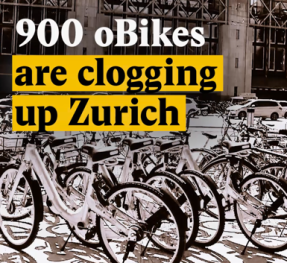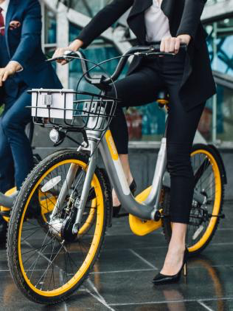The Sharing Economy is Learning How to Ride a Bike
Moving to a foreign country has a way of spurring experiments with lifestyle change. Our family has temporarily relocated to Switzerland where my kids have happily adjusted to the Swiss norms of chocolate, cheese, and snow consumption. As for me, I’ve been enjoying our car-free lifestyle. The Swiss make it relatively easy for everyone to get where they need to go by train, tram, or trail.

A trip to the grocery store with no backseat bickering!
Initially, my commute took some figuring out. When my work schedule allows, I ride trails designed to keep bike commuters safe and happy. But on days when I need to take the train, I am confronted with the infamous “first-mile-last-mile” (FMLM) problem. The train trip from home to work (in Zurich) is fast and time-efficient. But walking to and from the train station is not.
What to do about this problem (which helps explain why so many commuters drive cars when there are public transit options readily available)? The sharing economy has recently conceived of a two-wheeled solution that is taking Zurich and many other cities by storm. Over the past year, a growing number of “dockless” bike-share start-ups have descended on cities across the globe to help urbanites ride those first and last miles in style.
This phenomenon is generating lots of excitement. Last year, the pioneer start-up Mobike was crowned United Nations Champion of the Earth, a tribute to its “transformative contribution to low carbon public transport”. But it’s also stirring up controversy as a growing number of cities seek to limit – or ban – this dockless disruption.
The Dockless Disruptors
What’s new here? Bikes are not new. They’ve been around for centuries. And bike shares are not new. They’ve been operating for years. But past sharing programs have used a “dock-based” model where users must pick up and drop the bikes at a network of docks.
In 2016, an influx of start-ups launched an alternative. The idea is pretty simple. Leverage now ubiquitous high-speed mobile networks and modern smartphone capabilities and do away with expensive and limiting bike docks. Users download an app on their phone that allows them to geo-locate and unlock a nearby bike. In contrast to the old model, users can ride wherever they need to go and then lock the bike with their phone for the next user to find.
Sounds awesome! But if this dockless innovation is going to become a viable mobility option for the masses, reliability is key. In other words, if I am going to rely on a bike share to solve my first mile/last mile problem, I want to know that a bike (preferably easy to use and in good working order) will be waiting for me when I leave my house/get off my train/leave my office.
Dockless 1.0
One brute force (and expensive) way to ensure that bike share users find bikes when and where they want them is to blanket/litter the urban landscape with bikes. This is essentially the strategy deployed in China, the birthplace of dockless bike sharing. Last year, Chinese companies raised billions in venture capital and deployed millions of GPS tracked bikes in Chinese cities.
You may have seen photos of the chaos that ensued. Unlike dock-based systems, dockless systems can be rolled out practically overnight with no planning or oversight from city governments. In China, a lack of coordination between startups competing fiercely for market share resulted in serious over-supply. Huge bike trash heaps have become emblematic of the over-exuberance that fueled the first attempt to launch dockless bike shares into the mainstream.
 “A monument to industry’s arrogance”
“A monument to industry’s arrogance”
So dockless bike shares got off to a somewhat rocky start. But the venture capital is still flowing, so these bike shares are still rolling into cities around the world. Wary of being saddled with their own bike share nuisance, local governments are wrestling with the question: Should cities suppress or support these new dockless bike shares?
Are dockless bike shares a problem?
The strongest opponents argue that cities should shut these bike shares down before they get started. The primary concern is that an oversupply of poorly maintained bikes will lead to public nuisance and maintenance issues.
 The Swiss version of newsworthy chaos
The Swiss version of newsworthy chaos
It’s true, dockless bike shares do not have the most impressive track record so far. But as competition and regulatory oversight intensify, companies will face stronger incentives to balance supply and demand (to reduce costs) and mitigate nuisance (to keep their city hosts happy).
We’re already seeing innovations along these lines. Several companies have started to implement time-varying pricing. Some are paying people to ride bikes from low-demand to high-demand locations. Others have introduced a points system to penalize negative behavior (like parking bikes irresponsibly). It seems plausible that efficient pricing plus some well-crafted regulation could significantly reduce over-supply and clutter.
Are dockless bike shares a solution?
Proponents argue that cities should be working to support the success of bike shares because they can mitigate some pernicious urban problems. Cities around the world are grappling with traffic congestion, air pollution, and associated health issues. As urban populations grow and more cars try to squeeze into constrained urban infrastructure, these problems are only going to get worse.
Ultimately, the extent to which bike sharing can mitigate these problems will depend on whether bike share companies can succeed in luring a critical mass of city folk out of their comfortable cars and onto more sustainable transportation alternatives. I’ll confess, I am a bit skeptical. But I also underestimated the enthusiasm with which the millenials have embraced sharing everything from pets to parking spaces.
If the private sector wants to make a go of getting more people out of cars and onto bikes, I’m all for it. Provided they follow some basic rules of the road. Designing these rules is a fascinating work in progress as cities struggle to weigh the costs and benefits of bike sharing. Some of these costs and benefits (e.g. reduced congestion, consumer’s willingness to pay for convenience) can be systematically evaluated. But nuisance externalities are more subjective and harder to quantify. I think it’s worth noticing that, in photos documenting bike share nuisance, there is often other infrastructural clutter (like power lines and parking structures) that we tolerate or cease to notice. We should be willing to accept some level of bike clutter if the social benefits generated by dockless bike shares are sufficiently large.
It’s exciting to see so much experimentation with different bike sharing models in different cities around the globe. As companies collect terabytes of information from their users each day, it will be important to dig into these data and objectively evaluate what’s working and what’s not. Meanwhile, with four companies to choose from here in Zurich, I’ll be running my own private experiments with bike sharing. And interested to hear about yours.
Suggested citation: Fowlie, Meredith. “The Sharing Economy is Learning How to Ride a Bike.” Energy Institute Blog, UC Berkeley, February 20, 2018, https://energyathaas.wordpress.com/2018/02/20/the-sharing-economy-is-learning-how-to-ride-a-bike/
Categories




Nice post. I actually use a folding bicycle for the first and last miles to commute to the University in Toulouse. You can bring your own bike for free in french local trains but the space devoted to bikes a very limited and often crowded. Especially when trains are delayed, or during the frequent strikes, which I guess rarely happen in Switzerland. An alternative is to have two bikes: one in the first mile (train station) and one in the last. No bike to carry but it doubles investment and maintenance….
Thanks for your interesting article. I also live and work in Zurich, and move around by bike and public transport.Indeed, in four years in Switzerland, I have only needed to use a car once when moving from one city to another. And I have visited forgotten towns in the middle of the Alps!
To a certain degree, some bike clutter seems to me as an unavoidable consequence of high bike usage. Excessive bike supply clearly makes the case worst, but so does the lack of proper infrastructure. For decades, most cities have been designed and developed to facilitate car usage. If cities are serious about increasing the number of people riding around, they should consider how many bikes will be crossing their streets every day and why the streets may clog with them. As cars need wide roads, traffic lights and multiple stories, underground parking lots, bikes and riders need bike trails, roofed parking lots and quick-repair, pumping stations.
In many corners of Zurich, the scarcity of designated places to park our bikes induces many to lock them to the fence closest to your destination. Most train stations do have bike parking lots – typically saturated since early in the morning – but many older streets in the centre of the town are simply not ready to accommodate an increasing number of riders. And Zurich is much better prepared than Madrid, where I used to live. For example, we enjoy now an impressive CHF 14 m (USD ~15 m) parking lot at the Hauptbahnhof https://www.nzz.ch/zuerich/aktuell/ein-unterirdischer-prunkbau-fuer-velofahrer-beim-zuercher-hauptbahnhof-ld.1317220
Good article thanks Dr Fowlie. Too bad they don’t allow you to take your bike on the train like they do on Caltrain back new home!
Very interesting article Dr Fowlie. Thanks!
Nice post. Amsterdam is struggling with this issue. The “dump and run” strategy of the Chinese companies (and their personal-data-sucking apps) are troublesome.
Another possibility is to acquire a folding bicycle, such as a Brompton (https://www.brompton.com/) – also soon available in electric (https://www.brompton.com/Brompton-Electric)! London’s Boris Bikes (actually decided on by Ken Livingstone, his predecessor as mayor) are too heavy and poorly geared to be a pleasant ride.